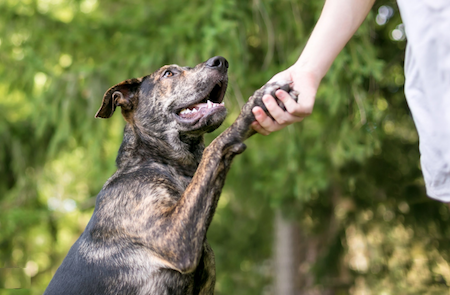The tone of voice of a trainer affects a dog’s emotions, learning, and performance.
Many people speak ‘baby talk” when speaking to dogs and babies. Science confirms that this is the best way to motivate and get a positive response from both humans and canines.
The mechanism
Speaking in ‘baby talk’ or ‘Motherese’ or ‘Doggerel’ is speaking in a positive tone which is often an octive higher in pitch and very singsong in tone. The observed and scientifically studied response to this style of speaking is that more attention is paid to this friendlier style and both babies and dogs have demonstrated a quicker response and faster learning when that tone is used.
Background / History
Our style of language changes depending on the situation we are in. We speak differently in a more formal setting like a bank, or in business transactions or when talking to  authorities or addressing an audience than we do when having a conversation with our friends or family. There is however, a different special kind of language when we are talking to babies and very young children. This style embraces a higher-pitched, almost musical tone, with many changes in harmony and repetitions. Researchers called it ‘Motherese’ although many felt it should have been called “infant-directed speech.” Even among individuals who are not mothers tend to use the same tones when speaking to very young children – it just works, gets positive responses and positive results. So why not dogs too? It just seemed to work better.
authorities or addressing an audience than we do when having a conversation with our friends or family. There is however, a different special kind of language when we are talking to babies and very young children. This style embraces a higher-pitched, almost musical tone, with many changes in harmony and repetitions. Researchers called it ‘Motherese’ although many felt it should have been called “infant-directed speech.” Even among individuals who are not mothers tend to use the same tones when speaking to very young children – it just works, gets positive responses and positive results. So why not dogs too? It just seemed to work better.
Apply This to Dogs
In the 1980’s psychologists showed that the language style that we use when talking to dogs is similar. While it should have been called “dog-directed speech,” was labeled “Doggerel.” Research over the decades has shown that children and dogs pay more attention when spoken to in Motherese or Doggerel.
Latest Research
A study published this month by researchers in the University of Veterinary Medicine, Vienna, were interested in finding out what happened during the process of domestication that changed wild wolves into our pet dogs and what possible roles humans played in the process.
For the study, a group of North American Gray Wolves and a group of medium-sized mixed-breed dogs originally obtained from animal shelters received testing and training for an hour or so each day. The training was all reward-based and included a number of basic commands (for example: sit, down, stand, stay, etc.) The training was the same for both wolves and dogs which included 270 video taped training sessions.
- The researchers’ first task was to evaluate the trainer’s vocalizations in this extensive set of training tapes. Specifically, they noted how trainers spoke during interactions with the dogs and a wolves, the tone they used, when they said the animal’s name, whether there were laughs, etc.
- Each speech unit was classified as being “nice” (a happy tone, generally high-pitched like Motherese), “neutral” (similar to that used to tell the dog what to do during training, without intense variations in intonation), or a sharper, “reproachful” or “reproving” tone of voice (such as the tone one might use when disapproving of some inappropriate behavior). Also, the average pitch of the voice sounds (high versus low) was measured.
The Emotional Response to Voice Tones
- As might have been expected, talking nicely with a high-pitched voice caused positive emotional responses in both the dogs and the wolves. Their tails wagged more, they stayed closer to their trainer, and they seemed to be more at ease. Furthermore, the longer and more frequently that the trainer spoke in this “nice” tone, the happier the animals seemed to be.
- The sharper, reproachful tone of voice caused the opposite effects in both dogs and wolves. Their tails wagged less, and they seemed to want to put as much distance as possible between themselves and the trainer. Again, the effects were greater when such reproving statements were longer and more frequently repeated.
Conclusions
- The authors conclude with a suggestion: “These findings recommend the use of a friendly approach. This strategy can potentially create a positive atmosphere, which may favor compliance with commands, and the development—by the animals—of a more positive emotional disposition.”
- If you want your dogs to not only feel better but also perform better in their training, you should talk sweetly to them. A little bit of high-pitched, singsong baby talk (or Doggerel) addressed to your dog can make a positive difference — and it even works for wolves.
[Link] [Link to Research Journal]
